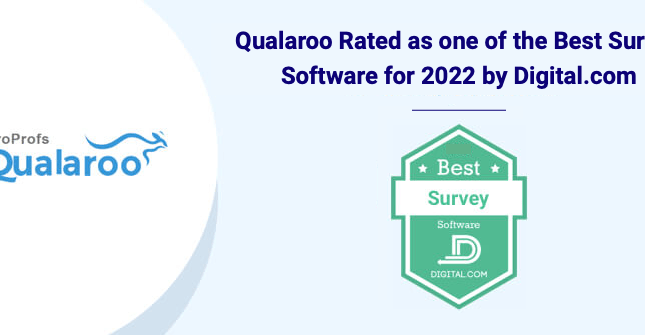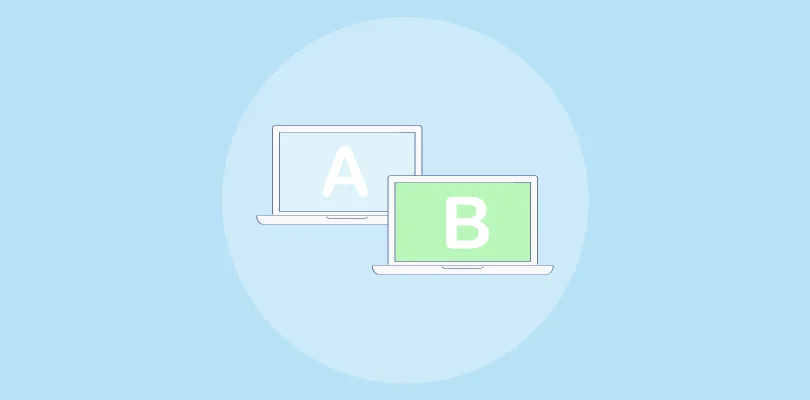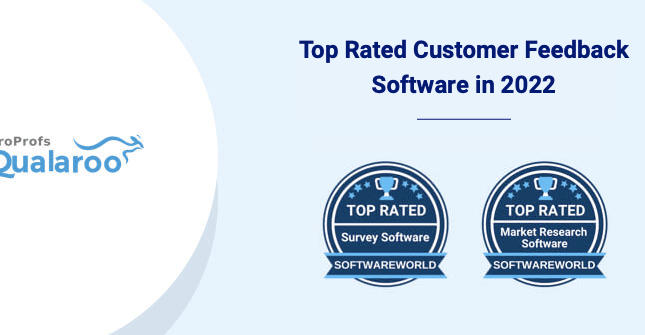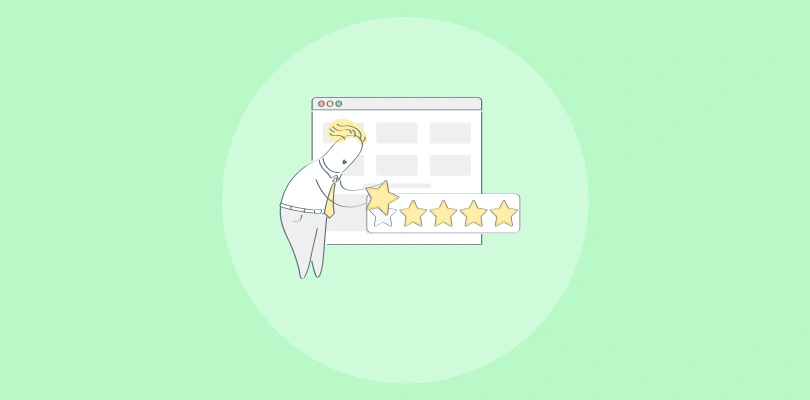According to a 2020 study, companies spend 50% more now on SaaS products than they did the year before. Also, the number of unique apps that SaaS companies are using has increased by about 30%.
The data shows that the demand is increasing, which is excellent news, but the market is becoming more and more competitive. Buyers have more options than ever, and B2B SaaS companies need to put in more effort to stand out.
This article will take you through sixteen SaaS marketing plans and tactics that any B2B SaaS company should consider in 2022.
But first, let’s quickly look at the definition of B2B SaaS marketing.
What is B2B SaaS Marketing: Definition
Considering that SaaS stands for “software as a service,” it means that SaaS marketing involves promoting software based on subscriptions.
A solid B2B SaaS marketing agency strategy brings the product to the right audience at the right time and emphasizes how the product brings value to the customer.
In this crowded market, buyers explore and evaluate many options before making a purchasing decision. Google calls this stage in the buyer’s journey the “messy middle”. That’s where you want to focus your B2B SaaS marketing plans and efforts.
If your organization can take the time to consider this new way people buy SaaS products, you’ll have a better grip on your marketing tactics as a whole.
How Can You Create an Effective B2B SaaS Marketing Strategy?
Before discussing the B2B SaaS marketing strategies to employ, let’s have a quick look at how you can create those effective strategies tailored to your business and requirements.
Assign Goals to Your B2B SaaS Marketing
Creating aimless SaaS strategies without a specific goal in mind is nothing short of wandering on the road – it leads to no destination.
So, before you make marketing strategies your priority, you need to add a goal to the top of your list.
What will your strategies aim to accomplish?
Is it to acquire more leads, boost brand awareness, or align your marketing and B2B SaaS sales strategy and technique?
The goal shouldn’t be abstract either. For example, simply generating more leads is not enough; you should clearly know how many leads you aim to acquire. Developing effective SaaS B2B marketing strategies will become easier if you have detailed goals.
Start with setting SMART (Specific, Measurable, Attainable, Relevant, and Timed) goals for your strategies, and the following steps will fall in line naturally.
Draft a Budget
If creating marketing strategies was only about creativity, then the sky would be the limit; but it’s not so, unfortunately. You need to think of a realistic budget to assign to your marketing campaigns and strategies.
If you allocate a reasonable budget beforehand, you won’t waste time thinking of strategies you can’t implement successfully.
Now, the question is, “how much of your revenue should you allocate to marketing B2B SaaS products?”
Generally, medium-sized or large businesses like Salesforce allocate 40-50% of their annual revenue.
But, it’s not all you are supposed to do. Drafting a budget comprises allocating funds and distributing them for different SaaS strategies. It is about managing funds in case of unforeseen costs and what tactics are worth spending more for your business.
Develop Marketing Tactics
Once the budget is set, you can now think about what you need to do to achieve the goals you have set. You can follow a few points to effectively design and implement your B2B SaaS marketing strategies.
- Understand your audience: It’s impossible to design successful B2B marketing strategies for SaaS businesses if you don’t know your target audience. It’s all the more critical now since personalized marketing is highly prevalent.
You cannot convince people to become your customers if you are convincing them the wrong way. If you know who you want to target, you’ll be able to crack the “How” part, and that’s how you create successful marketing strategies.
- Re-evaluate your current strategies: Before brainstorming for new strategies and engaging your resources in the process, it’s wise to re-evaluate your current SaaS strategies and rule out the ones not working. This way, you will clearly understand what has worked for you in the past and what direction to follow.
How Do SaaS Companies Stand Out From the Competition?
Every market is full of cut-throat competition, and SaaS is no different. Companies still make it to the top tier level to bag customers and profits alike with just the right strategies.
So, let’s cover what SaaS companies do to make the potential prospects notice them and turn them into customers.
1. Devise a UI/UX Strategy
One of the key strategies globally successful businesses use is influencing consumer behavior in your favor. One way to do this is to prepare effective user experience (UX) strategies with an intuitive and interactive user interface (UI).
Providing user satisfaction involves creating a seamless and positive experience for your customers/users, from your website, mobile app, to software products.
You need to ensure that the user interface of your website or mobile app and your software product is efficient. Thus, developing these well-defined strategies will help you focus on these main points.
One way to go about it is pop-up surveys. UX designers can use surveys to gather in-context feedback from website visitors or users and put the finger on what needs improvement.
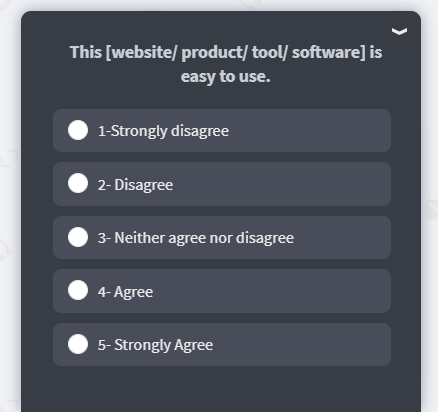
They can place surveys in prototypes or any specific pages of a website to minimize usability issues by asking users about their experience and what they think is working or not.
Bonus Read: Guide to Surveying Users
Here are some examples of survey questions that you can ask to gather contextual feedback:
“What were you hoping to find on this page?”
“Did this page meet your expectations?”
“Is there anything on this site that doesn’t work the way you expected it to?”
“Does this page contain the information you were looking for?”
“What could we do to make this site more useful?”
There are just a few examples to give you an idea and get you started. For more ideas, check out this survey question library.
Related Read: Best UI/UX design software in 2022
2. Find What Makes You Unique
Generally, products are the main components that set a company apart from the competition. The better the product, the better your business will perform than the competitors.
To create robust products and undefeatable SaaS strategies, many companies use on-site surveys to collect user feedback and gauge what features/updates customers want to add/remove from the product to create a customer-centric experience and boost satisfaction for your products. Here is an example:
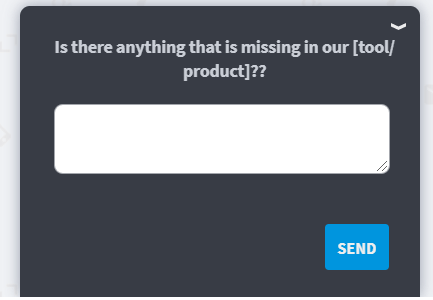
Besides this parameter, other factors can make your SaaS unique and stand out from the competition. Some pointers which you should consider to stand out are:
- Offer better customer-centric services and support
- Focus on different and diverse audiences and segments
- Ensure seamless UI and UX across all channels, platforms, and departments
- Create less frictional flows in the user journey
3. Plan a Long-Term Business Model
Create a website to convey your vision, mission, and goals. Establish a robust digital presence for your business and connect better with your customers.
There are many “standard” business models for SaaS startups to try. One of the popular ones is venture capital. Many startups from the onset rely on venture capital, while others start slowly, both keeping the long-term benefits in mind. These are the two options that create a base for the business model.
To further ensure you build a long-term business model, you need to keep improving your conversion rate and bringing in more business. You can use the customer feedback you collect to identify areas of improvement and re-evaluate your value proposition, pricing, and other crucial elements.
You can also use the feedback to:
Run A/B testing for your website ⇒ Check the Net Promoter Score (NPS as shown below) using the feedback surveys ⇒ Redefine your SaaS B2B marketing strategies.
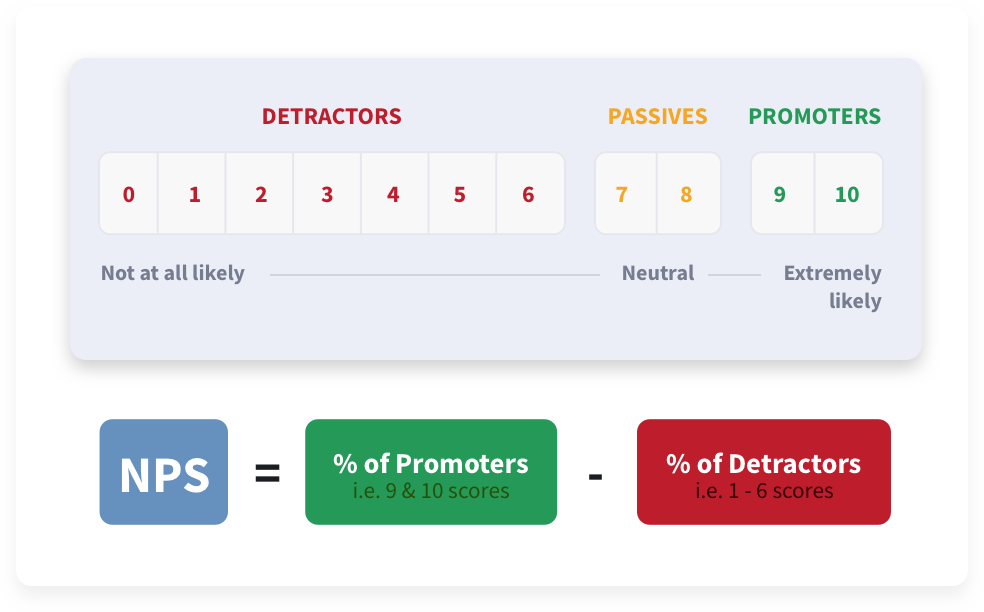
All in all, a long-term business model is only possible as long as you stay relevant and focused on your customers’ needs.
Bonus Read: Best NPS Software
4. Focus on Value Instead of Cost in Competition
One of the most common and rookie mistakes SaaS startups make is considering the cost as their competitive advantage. Sure, it is in e-commerce or other industries, but SaaS is different. Here, the customers’ primary goal is to find a product that works and has lower costs and discounts.
If your product does not have value for customers, it will never become a hit, no matter how competitive your prices are. But, if it performs well and has value for customers, then they will pay reasonably.
Additionally, price is not a stable competitive advantage, as you only have the upper hand until someone else comes with even lower prices. It results in pricing wars, where your margins get sliver to the point; it’s not sustainable for your business in the longer run.
Now, let’s dive into the fundamental tactics any B2B SaaS company should consider to grow its business.
16 Proven B2B Saas Marketing Strategies to Grow Your Business
With everything else out of the way, we can finally look at the time-tested B2B marketing strategies for SaaS you can apply for your business.
1. Quality Content for the Win
Saying that content can make or break your marketing won’t be overstating it. Creating and putting out quality content establishes you as an industry thought leader, naturally boosting your brand image.
Content, such as blog posts, case studies, books, whitepapers, podcasts, social media posts, etc., makes for a great B2B marketing strategy. Such content allows your brand to reach your targeted audience, introduce them to your company’s mission and services and boost recognition.
It is crucial to understand that we don’t mean over-the-top promotional articles and posts when we say content. Quality content is education and helps your customers learn something they are interested in, which is helpful to them.
Take Neil Patel, for example; you can access several courses and guides for free and expand your knowledge on digital marketing without actually becoming a customer.
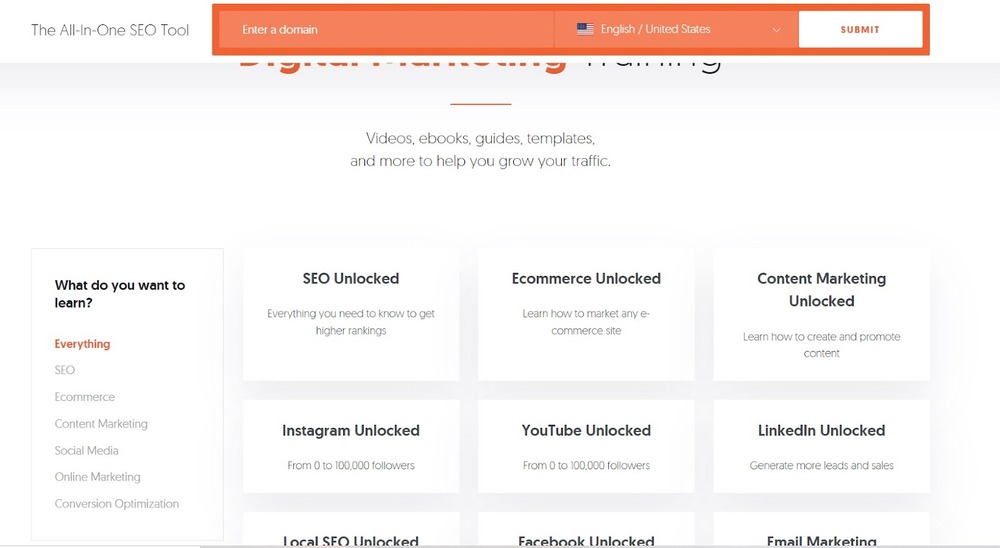
Similarly, Qualaroo shares insightful content to create a delightful customer experience. For example, you can find guides and educational videos to understand how to listen to your customers’ feedback.
2. Work on Social Media Presence
Any smart organization knows the importance of having an online presence on social media and what it can do for your business.
It is the single most effective strategy nowadays to connect to your customers on a personal level and foster a loyal relationship. Constant interaction with your audience keeps you in their minds, having a more lasting impression than any ad campaign.
Many SaaS companies took a page from Elon Musk’s book of relationship-building and now interact with customers on social platforms.
For example, Adobe interacts regularly with its customers to give them extra information on products and pricing or troubleshoot whenever customers reach out to them with issues.
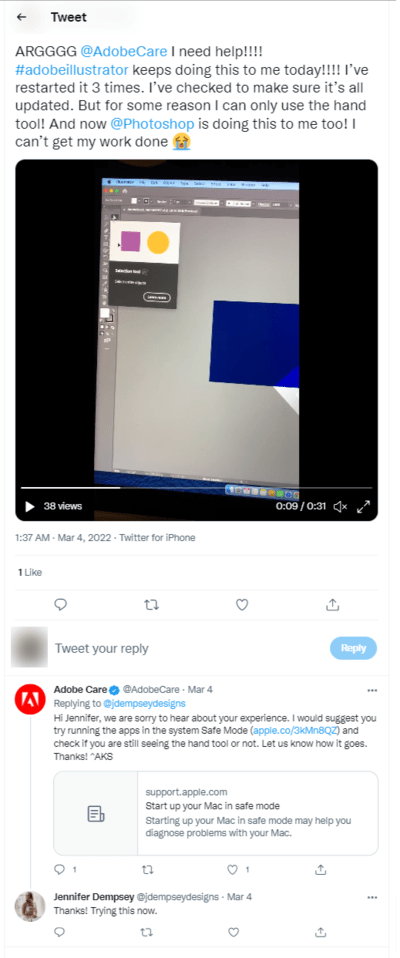
And here’s another example of how it’s done on Twitter:
Platforms such as Instagram, LinkedIn, Twitter, and Facebook overflow with brands interacting with their customers and building a solid social media presence. So, as a SaaS brand, you should get on this bandwagon and see the magic happen.
3. Keep the Community Alive
With a great social media presence comes great responsibility to sustain the community.
If you play your cards right, followers will be pouring in on your social media. The next natural step is to keep them engaged with informative content and keep the community alive.
Companies invest in online webinars and create forums or groups on social media to educate and engage customers. It is a way to entertain the audience while listening to and resolving their issues.
4. Promote Testimonials and Partnerships on Major Places
Customer testimonials & partnerships are a testament to your credibility and that customers can trust your products & services.
Even as customers, we tend to look at the brand, its online presence, and customer reviews before making a purchase. People trust people and their experiences more than any marketing campaign.
So, why not use this valuable resource and turn it into your portfolio of loyal customers and their trust in your brand?
You can access customer testimonials from forums, comments on your social media post, and customer feedback tools that capture your customers’ verbatim feedback.
For example, Qualaroo is a survey tool that allows you to create surveys and capture customer responses. You can use these responses as testimonials on your website, as shown below.
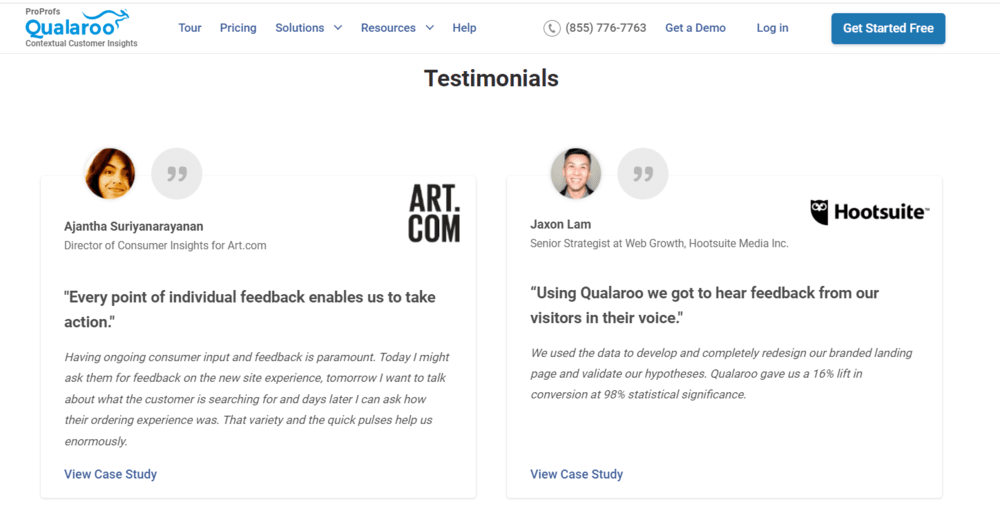
Also, you should showcase your top-tier customers on your website homepage to induce trust in customers.

5. Devise a Referral Program
Besides using the power of social media, you can employ another B2B marketing strategy simultaneously – A referral program.
Referral programs play on the phenomenon that people prefer to purchase a product when recommended by someone they know and trust. An effective referral program will help you acquire more leads, boost your sign-ups, and bring in a targeted audience.
In return, you offer some benefits to both referring and the referred customers. For example, Trello, a project collaboration platform, uses a referral program where customers get a free month of Trello Gold if they refer to one person.
So, if a customer refers to 12 people, they can enjoy a whole year of Trello Gold. Not only did Trello increase its customer base this way, but also spread awareness about its premium plan.
6. Introduce a Variety of Pricing Plans
More often than not, customers are not satisfied with the pricing and may ask for more personalized plans. Especially for a SaaS business, it’s crucial to listen to its customers and cater to businesses of all sizes to expand their horizons.
Different pricing plans allow customers to choose the one they see fit and can afford. Doing so lets customers know you are aware of their limitations and needs and proactively deliver on these fronts.
7. Video Marketing Is the New Black
Video marketing has taken social media by storm, and it’s everywhere. People have started to consume more content, and brands have stepped up to incorporate this customer need into their B2B marketing strategy.
You can use your video content in multiple ways and market it to relevant audiences to generate more leads while educating your existing customers.
For example, Neil Patel publishes his videos on social media and interacts with the comments, ensuring to engage more and more audience.
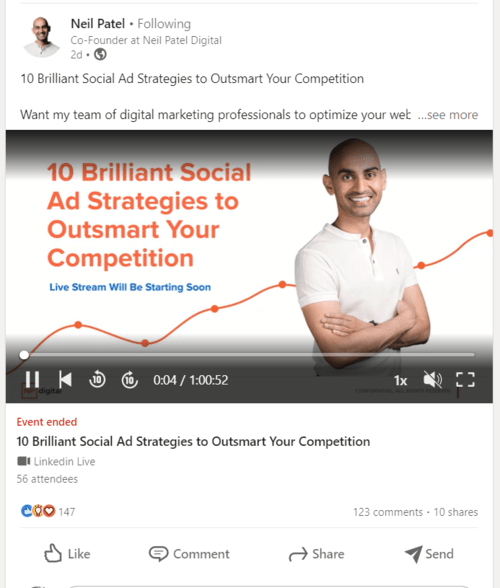
8. Keep SEO a Priority
Search engine optimization (SEO) is a marketing strategy that focuses on driving organic leads to your website by ensuring your website ranks higher on search engines. It’s true that SEO includes adding high-performing keywords to your content, but it’s broader than this.
An effective SEO strategy will drive leads to your sales funnel without needing the help of Google ads.
It focuses on your whole website, like how well it is designed as per Google, the primary keywords for your target audience, and natural backlinking to improve your website’s DA (Domain Authority).
Once you know the right keywords to target, you can optimize your website for the Google search engine to rank in the top spots, increasing your brand visibility.
You can conduct A/B testing to improve your website’s performance and align your content marketing with your SEO strategy.
[Read more: The Ultimate Guide to SEO for UX Designers]
9. Improve Your PPC Campaigns
Pay-per-click or PPC advertising is one of the most popular B2B SaaS marketing tactics. Even for companies that do well on the SEO front, PPC is still something they invest in because of the level of control it gives you.
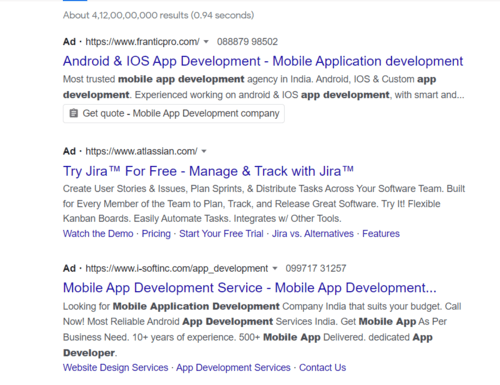
Plus, paid search costs less than half of the amount spent on a traditional ad published elsewhere.
With that said, some best performing paid ads have a few things in common:
- They start with a general benefit but also make a specific promise
- They address a pain point
- They show you the way you’ll benefit from their product
Remember that your SEO strategy should partially support your PPC campaign. For example, your strategy should achieve a top rank for the PPC keywords or phrases you are targeting.
You should also pay attention to the ad quality score, i.e., make sure you offer some value through those ads and not just mention your landing pages and home page.
10. Leverage SaaS-Centric Review Portals
Specifically, in the case of SaaS businesses, whenever you search a related keyword, the first few results are always from forums and review sites. For example, if you search the keywords, the first three results are of such websites, as shown in the image.
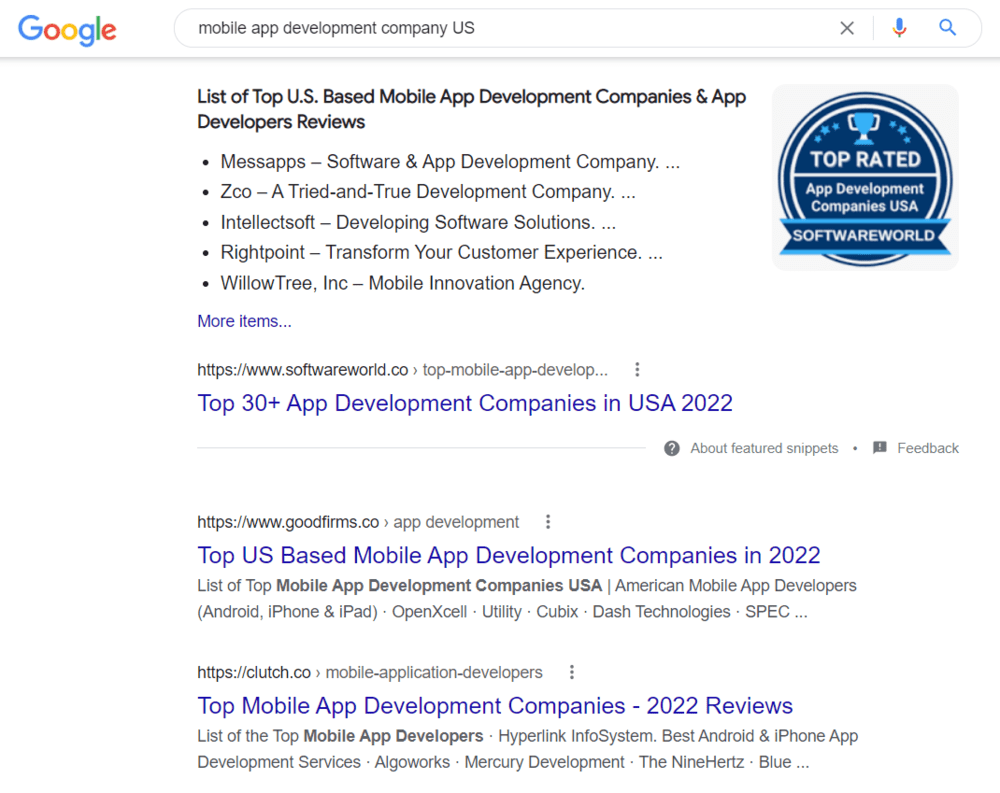
It clearly shows that these websites are essential for leads, and they do check out your company and look for customer reviews. In this case, it’s wise to have your company represented on these websites accurately.
You can reach out to websites like Capterra, G2, Crows Reviews, Software Suggest, Clutch, etc., and have your company listed there. If this hasn’t been a part of your SaaS marketing strategy, you are missing out big time and should do it ASAP.
11. Make SaaS Sign-Ups Snappy
No one likes lengthy sign-ups that take forever to complete. For customers, their time is essential. A few seconds make or break the customer experience. And surely, you don’t want to blow it just because you added a question or two that take a few more seconds.
So, it’s better to keep the signup process crisp even if you are offering a free trial. Carefully analyze your signup process and remove any steps that feel unnecessary and forced.
Here’s an in-house example of how live chat tool ProProfs Chat increased sign-ups by almost 30% by tweaking its sign-up page.
ProProfs Chat saw a massive drop-off of prospects after they were landing on the sign-up page. Not many visitors who clicked on the sign-up CTA button got through the process since the sign-up form was too long.
Using Qualaroo Nudges and Microsoft Clarity’s Session Recording feature, ProProfs Chat overhauled its sign-up form to make it crisper and made the process step-by-step & conversational to see almost a 30% increase in monthly signups.
12. Improvise Call-to-Action
A critical step in your content marketing strategy is a call-to-action at the end of every content.
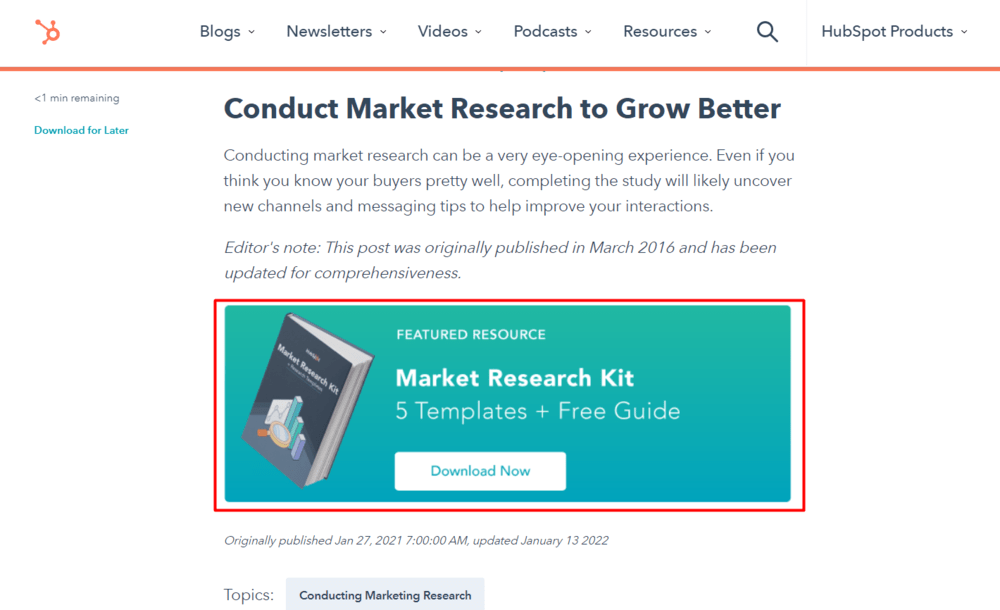
The whole purpose of creating content is to bring leads closer to becoming a customer. Achieving this goal will not be possible if you don’t give them a goal or action after engaging with your content.
It is why placing CTAs at crucial touchpoints throughout the customer journey is pivotal to expanding your sales funnel.
13. Give in-App Product Tours
SaaS customer acquisition and retention are tightly related to the product’s perceived value. If customers manage to make the most out of the tools you provide, they’ll likely convert more, stay longer and even recommend your product to their peers.
One of the best ways to make sure your product is well understood is to give product tours. According to Invisionapp, a product tour can help improve B2B SaaS sales conversions by at least 20%.
When should I give a product tour?
Ideally, give the product tour as soon as possible when users sign up and first interact with your product. You can also engage existing customers with short tours of new features.
For example, project management tool Teamwork shows new users their progress with the features available, how many features they used, and how many are still to be discovered. Every feature comes with a short video tutorial and links to a knowledge base to help you learn more.
If you’re looking for a tool to help you set up a step-by-step product tour, you can try Stonly or Intercom.
14. Start an Affiliate Program
An affiliate program is something B2C brands have been using for a long time to boost their sales. More and more B2B SaaS brands have started adopting this channel to reach new audiences using bloggers and social media influencers.
How to Search Online for Companies That Run Affiliate Programs
If you’re looking for examples of companies that run Affiliate programs, use advanced search operators like these to spot dedicated pages:
- intitle:” affiliate program”
- Intitle:” referral commissions”
- Inurl:affiliates
Affise, Impact, and Voluum are just a few examples of affiliate tracking software you might consider if you’re starting with an affiliate program.
15. Make It Easy for Prospects to Book Calls & Demos
If you’re looking to convert your content leads into actual marketing qualified leads, then make it easy for them to either book a call or a demo with your team. For that, it’s essential to pay attention to the way you design your landing page:
- Reduce the number of form fields
- Include social proof such as video testimonials or quotes for customers
- Consider adding a short video demo
For example, Qualaroo makes it easy for prospects to book a demo call whenever it suits their calendar:
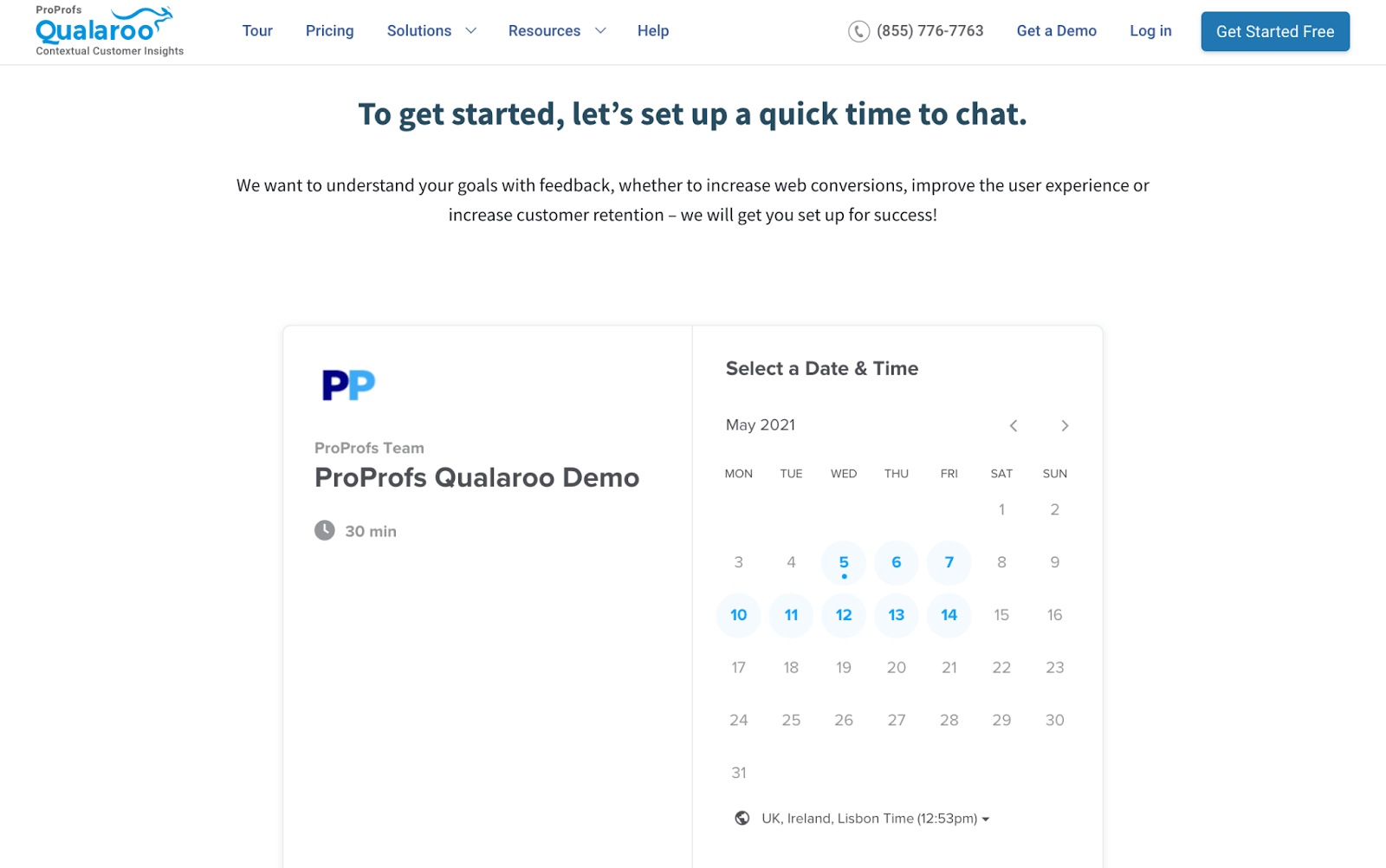
16. Curate Reviews and Customer Feedback Along with Success Stories
Irrespective of how intuitive the UI of your product is or how feature-rich it is, users would never know about it before trying, which is only possible when they purchase subscription plans or sign up for a trial. But there is another way – customer reviews and testimonials.
How Can a Company Motivate Its Potential Users to Try Their Product?
For starters, you need to develop trust in them towards your products, and the best way to do this is to show them what other customers think of and experience with your product. Now, acquiring honest and detailed reviews and testimonials is easier said than done.
So, for this purpose, many companies deploy survey tools like Qualaroo and ProProfs Survey Maker to gather customer feedback about their products and services and extract reviews and testimonials worthy information.
And the best part?
You can get contextual feedback that is richer and more meaningful than just a general survey. You can strategically place surveys with specific triggers to collect in-context feedback and gain an in-depth view of user experience.
Features like sentiment analysis in such survey tools help you skim through tons of feedback and select the most helpful information to use as success stories and reviews for potential clients as proof.
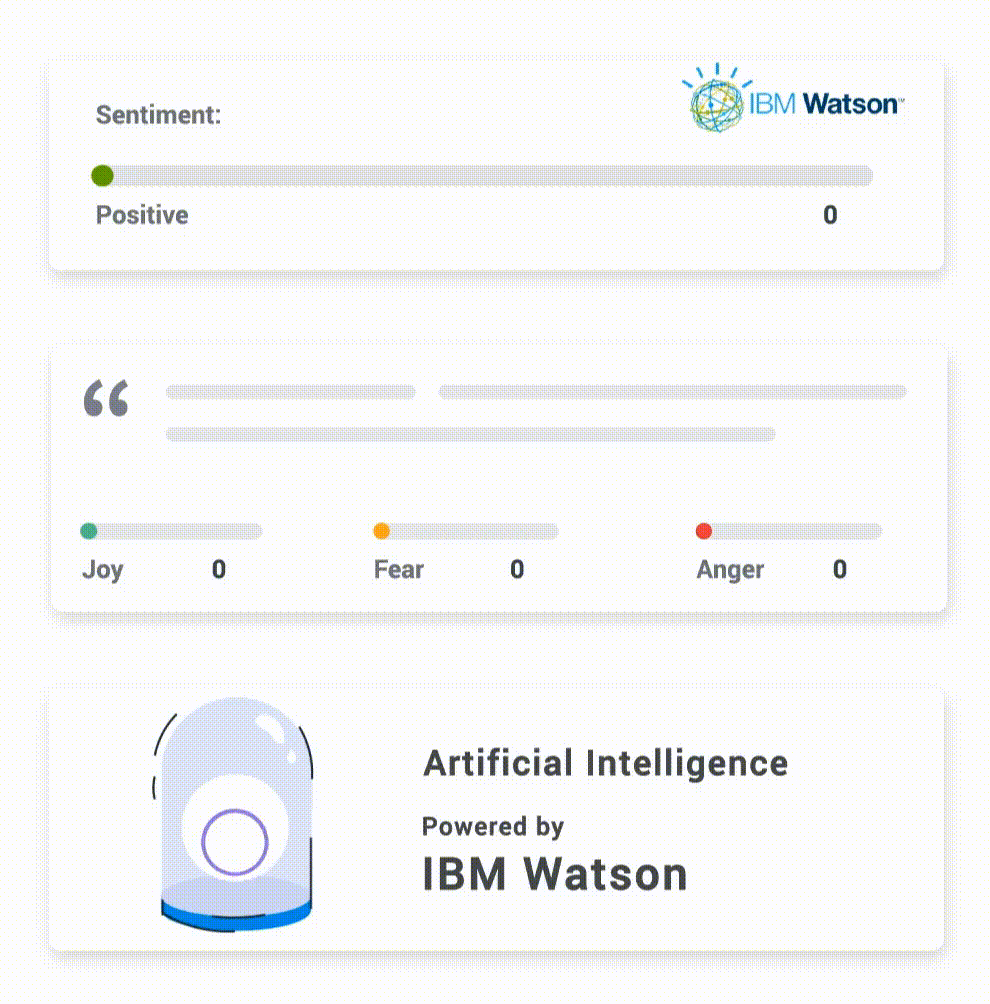
Such survey and analytics tools use the “word cloud” feature to access the verbatim responses of users and highlight the frequently used vocabulary in the feedback. You can select any word from the word cloud and select the reviews best representing your business as powerful testimonials.
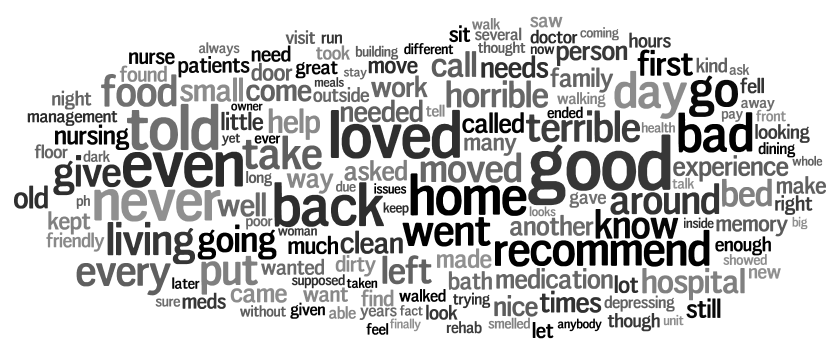
Besides Sentiment Analysis, you can also collect contextual insights from existing customers using exit-intent survey pop-ups. Some tools let you place exit-intent surveys that appear correct when the visitors leave the website to ask them what went wrong and how you can improve their experience.
FREE. All Features. FOREVER!
Try our Forever FREE account with all premium features!
FAQ Questions
Q: What are the different types of B2B Saas Marketing Strategies?
A: Different marketing strategies include producing quality content, maintaining social media presence, practicing video marketing, performing SEO, improving PPC campaigns, providing in-product tours, and much more.
Q: Which B2B SaaS marketing channels to use?
A: You can perform B2B marketing on various channels and platforms like search engines (Bing, Google ads), LinkedIn lead cards, Capterra, Facebook, Twitter, Instagram, Quora, Affiliate, and more.
 Tips
Tips
We’d love to hear your tips & suggestions on this article!
FREE. All Features. FOREVER!
Try our Forever FREE account with all premium features!

 We'd love your feedback!
We'd love your feedback! Thanks for your feedback!
Thanks for your feedback!


